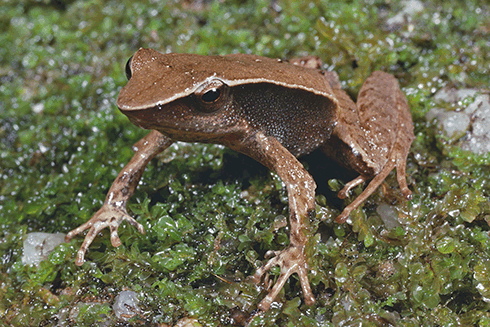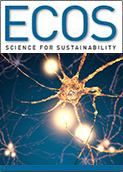
|
Published: 5 May 2014
Protective skin probiotics may help endangered frogs
A sample of the protective mucus layer that coats a frog's skin can now be analysed to determine how susceptible the frog is to disease, so that they can be ‘armoured’ with probiotics, according to an article recently published in the open-access journal PLOS ONE.

|
|
Australia’s sharp-snouted day frog, presumed extinct, is one of many frog species worldwide, including Panama’s golden frog, decimated by the skin pathogen, chytrid fungus. Credit:
© Martin Cohen
|
The technique should enable researchers to determine what kind of probiotic skin wash might be most effective at bolstering the frog's defences without actually exposing the frog to disease, according to the article.
This will in turn enable conservationists to reintroduce endangered amphibian species into the wild with a reduced risk of them being killed by microorganisms that may have played a role in the species' decline.
‘We have all these amphibians in captivity now, like the golden frog in Panama, a really beautiful species that is now extinct in the wild,’ said Douglas Woodhams, a postdoctoral researcher at University of Colorado Boulder in the US, and lead author of the paper.
‘We want to be able to reintroduce them, but the pathogen that attacked them is still out there. Now we can determine what probiotic treatment might work best to protect the frogs without infecting them with the pathogen and seeing how many die.’
Woodhams describes the amphibian skin as ‘a micro-ecosystem’.
The mucus that coats amphibians is home to a teeming community of microbes and also contains biochemical defences secreted by the animal itself. The interplay between these microbes – which include beneficial and pathogenic species of bacteria and fungi – and the biochemical defences determine how susceptible the amphibian is to a particular disease.
Woodhams’ team studied midwife toads, which live in Europe and are highly susceptible to chytrid fungus, a skin disease that is devastating amphibian populations across the globe.
After collecting samples from the frogs' skins, they incubated spores from the chytrid fungus in the mucus. The ability of the mucus samples to kill the fungal disease was related to how prevalent the infections were among the frog population in the field, as well as the survival rate of frogs raised in the laboratory that were exposed to the disease.
The correlations mean that scientists no longer have to expose frogs to the disease to determine whether the frog is susceptible to it.
‘We can assess the risk of disease in different species and populations by this method, and focus resources were they are most needed,’ Woodhams said. ‘Now we can just test the mucus to see how susceptible the amphibian is.’
The research team also used mucus tests to determine how effective probiotic treatments would be at increasing amphibian defenses against disease in a range of environmental conditions and at a range of life stages.
Because the microbial community in the mucus of each amphibian species differs, adding a particular type of bacteria to the mucus through a probiotic wash will have different impacts on different types of frogs.
To determine which probiotic would work best for which frog, the researchers added the probiotic to the mucus before incubating the fungal spores in the sample. The researchers could then determine the effect of the probiotic by observing whether the spores were able to survive in the mucus or whether they were killed off.
They also found the survival rate of the fungal spores differed depending on environmental conditions. For example, the bacteria Serratia plymuthica, which can be found on the skin of midwife toads, is known to fight off fungal infections. But when the researchers increased the temperature at which the fungal spores were incubated in a mucus sample containing the bacteria, the results flipped. An increase of about 5°C caused the bacteria to actually encourage the growth of the fungus instead of inhibiting it.
This type of environmental information can help scientists determine where the best location to reintroduce an endangered amphibian species might be by understanding what environmental conditions might bolster the frog's own defences, Woodhams said.
Source: University of Colorado Boulder



